An Analysis of the Foreign Exchange Market's Impact on Investors
VerifiedAdded on 2023/01/11
|31
|10666
|64
Thesis and Dissertation
AI Summary
This dissertation explores the foreign exchange market, examining its impact on investors and company prices. The introduction provides an overview of the market, its history, and its significance, including the rationale, purpose, aim, and objectives of the research. The literature review analyzes various theories and themes related to the forex market, including derivative markets, hedging strategies, and the evolution of the market. The research methodology outlines the methods, approaches, and design used in the study, covering data collection, analysis, and ethical considerations. Subsequent chapters will delve into data analysis, findings, discussion, and conclusions, offering insights into market efficiency, trading decisions, and risk management within the foreign exchange market. The research aims to identify factors impacting market efficiency and provide valuable information for investors, including hedging strategies and risk mitigation techniques. References are included to support the research.

Dissertation
Paraphrase This Document
Need a fresh take? Get an instant paraphrase of this document with our AI Paraphraser
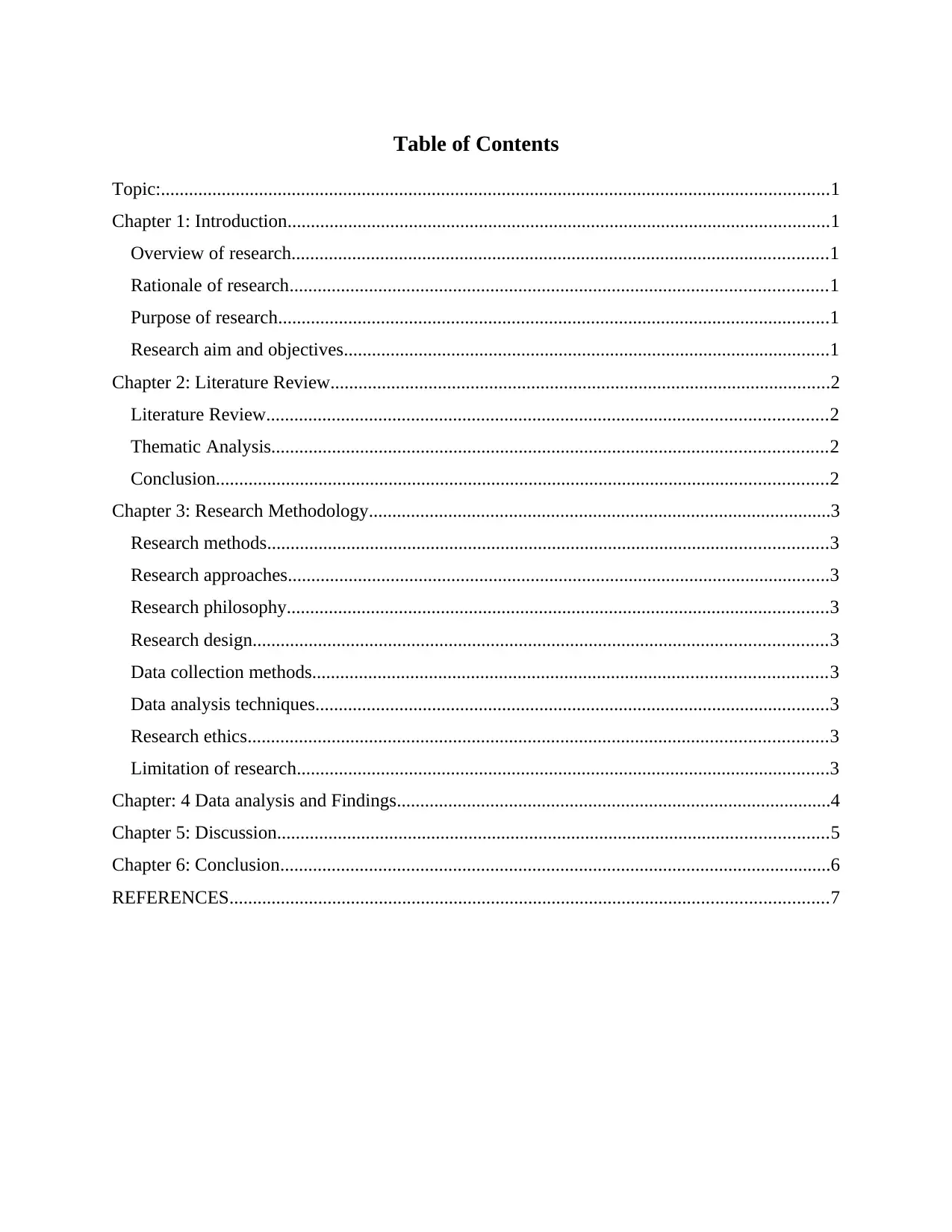
Table of Contents
Topic:...............................................................................................................................................1
Chapter 1: Introduction....................................................................................................................1
Overview of research...................................................................................................................1
Rationale of research...................................................................................................................1
Purpose of research......................................................................................................................1
Research aim and objectives........................................................................................................1
Chapter 2: Literature Review...........................................................................................................2
Literature Review........................................................................................................................2
Thematic Analysis.......................................................................................................................2
Conclusion...................................................................................................................................2
Chapter 3: Research Methodology...................................................................................................3
Research methods........................................................................................................................3
Research approaches....................................................................................................................3
Research philosophy....................................................................................................................3
Research design...........................................................................................................................3
Data collection methods..............................................................................................................3
Data analysis techniques..............................................................................................................3
Research ethics............................................................................................................................3
Limitation of research..................................................................................................................3
Chapter: 4 Data analysis and Findings.............................................................................................4
Chapter 5: Discussion......................................................................................................................5
Chapter 6: Conclusion......................................................................................................................6
REFERENCES................................................................................................................................7
Topic:...............................................................................................................................................1
Chapter 1: Introduction....................................................................................................................1
Overview of research...................................................................................................................1
Rationale of research...................................................................................................................1
Purpose of research......................................................................................................................1
Research aim and objectives........................................................................................................1
Chapter 2: Literature Review...........................................................................................................2
Literature Review........................................................................................................................2
Thematic Analysis.......................................................................................................................2
Conclusion...................................................................................................................................2
Chapter 3: Research Methodology...................................................................................................3
Research methods........................................................................................................................3
Research approaches....................................................................................................................3
Research philosophy....................................................................................................................3
Research design...........................................................................................................................3
Data collection methods..............................................................................................................3
Data analysis techniques..............................................................................................................3
Research ethics............................................................................................................................3
Limitation of research..................................................................................................................3
Chapter: 4 Data analysis and Findings.............................................................................................4
Chapter 5: Discussion......................................................................................................................5
Chapter 6: Conclusion......................................................................................................................6
REFERENCES................................................................................................................................7

⊘ This is a preview!⊘
Do you want full access?
Subscribe today to unlock all pages.

Trusted by 1+ million students worldwide
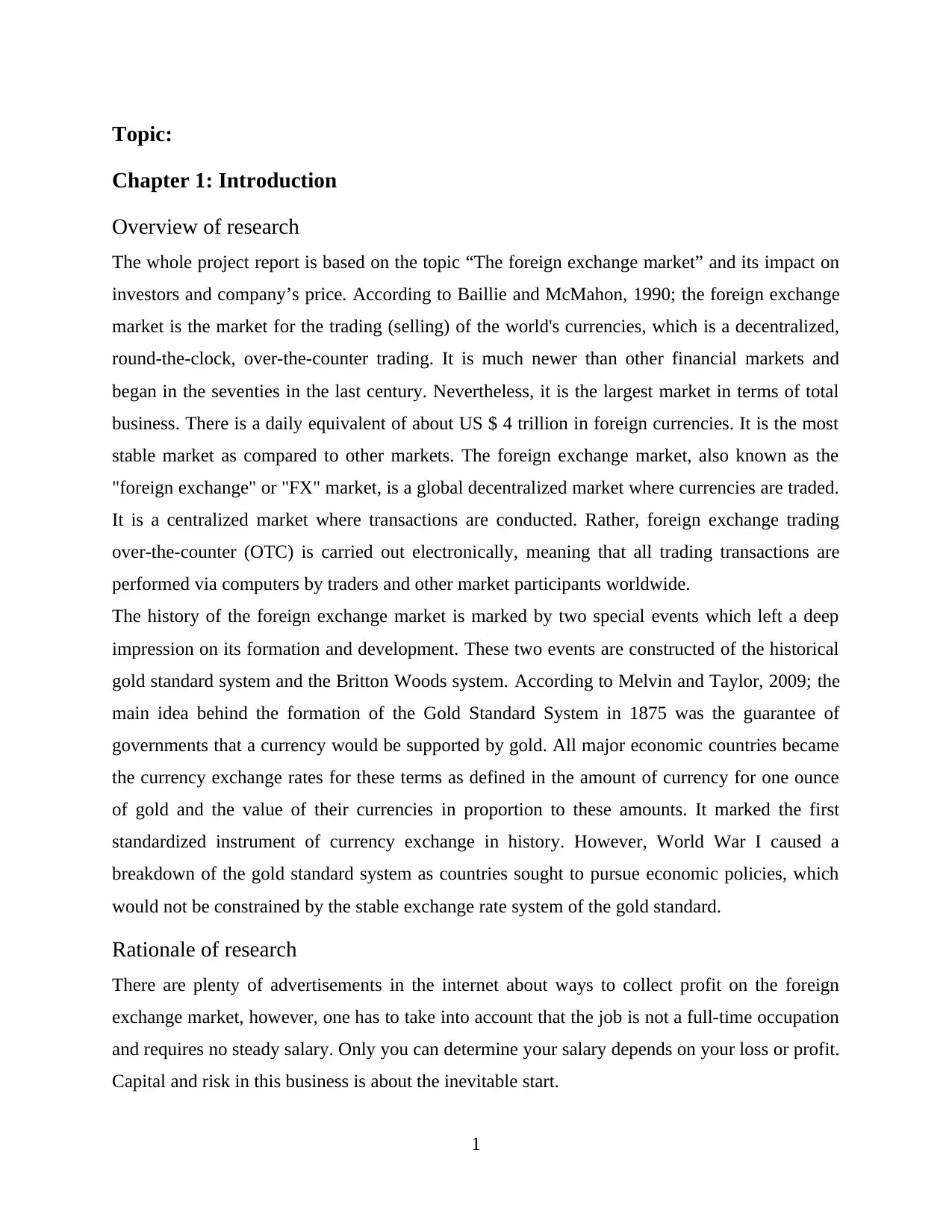
Topic:
Chapter 1: Introduction
Overview of research
The whole project report is based on the topic “The foreign exchange market” and its impact on
investors and company’s price. According to Baillie and McMahon, 1990; the foreign exchange
market is the market for the trading (selling) of the world's currencies, which is a decentralized,
round-the-clock, over-the-counter trading. It is much newer than other financial markets and
began in the seventies in the last century. Nevertheless, it is the largest market in terms of total
business. There is a daily equivalent of about US $ 4 trillion in foreign currencies. It is the most
stable market as compared to other markets. The foreign exchange market, also known as the
"foreign exchange" or "FX" market, is a global decentralized market where currencies are traded.
It is a centralized market where transactions are conducted. Rather, foreign exchange trading
over-the-counter (OTC) is carried out electronically, meaning that all trading transactions are
performed via computers by traders and other market participants worldwide.
The history of the foreign exchange market is marked by two special events which left a deep
impression on its formation and development. These two events are constructed of the historical
gold standard system and the Britton Woods system. According to Melvin and Taylor, 2009; the
main idea behind the formation of the Gold Standard System in 1875 was the guarantee of
governments that a currency would be supported by gold. All major economic countries became
the currency exchange rates for these terms as defined in the amount of currency for one ounce
of gold and the value of their currencies in proportion to these amounts. It marked the first
standardized instrument of currency exchange in history. However, World War I caused a
breakdown of the gold standard system as countries sought to pursue economic policies, which
would not be constrained by the stable exchange rate system of the gold standard.
Rationale of research
There are plenty of advertisements in the internet about ways to collect profit on the foreign
exchange market, however, one has to take into account that the job is not a full-time occupation
and requires no steady salary. Only you can determine your salary depends on your loss or profit.
Capital and risk in this business is about the inevitable start.
1
Chapter 1: Introduction
Overview of research
The whole project report is based on the topic “The foreign exchange market” and its impact on
investors and company’s price. According to Baillie and McMahon, 1990; the foreign exchange
market is the market for the trading (selling) of the world's currencies, which is a decentralized,
round-the-clock, over-the-counter trading. It is much newer than other financial markets and
began in the seventies in the last century. Nevertheless, it is the largest market in terms of total
business. There is a daily equivalent of about US $ 4 trillion in foreign currencies. It is the most
stable market as compared to other markets. The foreign exchange market, also known as the
"foreign exchange" or "FX" market, is a global decentralized market where currencies are traded.
It is a centralized market where transactions are conducted. Rather, foreign exchange trading
over-the-counter (OTC) is carried out electronically, meaning that all trading transactions are
performed via computers by traders and other market participants worldwide.
The history of the foreign exchange market is marked by two special events which left a deep
impression on its formation and development. These two events are constructed of the historical
gold standard system and the Britton Woods system. According to Melvin and Taylor, 2009; the
main idea behind the formation of the Gold Standard System in 1875 was the guarantee of
governments that a currency would be supported by gold. All major economic countries became
the currency exchange rates for these terms as defined in the amount of currency for one ounce
of gold and the value of their currencies in proportion to these amounts. It marked the first
standardized instrument of currency exchange in history. However, World War I caused a
breakdown of the gold standard system as countries sought to pursue economic policies, which
would not be constrained by the stable exchange rate system of the gold standard.
Rationale of research
There are plenty of advertisements in the internet about ways to collect profit on the foreign
exchange market, however, one has to take into account that the job is not a full-time occupation
and requires no steady salary. Only you can determine your salary depends on your loss or profit.
Capital and risk in this business is about the inevitable start.
1
Paraphrase This Document
Need a fresh take? Get an instant paraphrase of this document with our AI Paraphraser
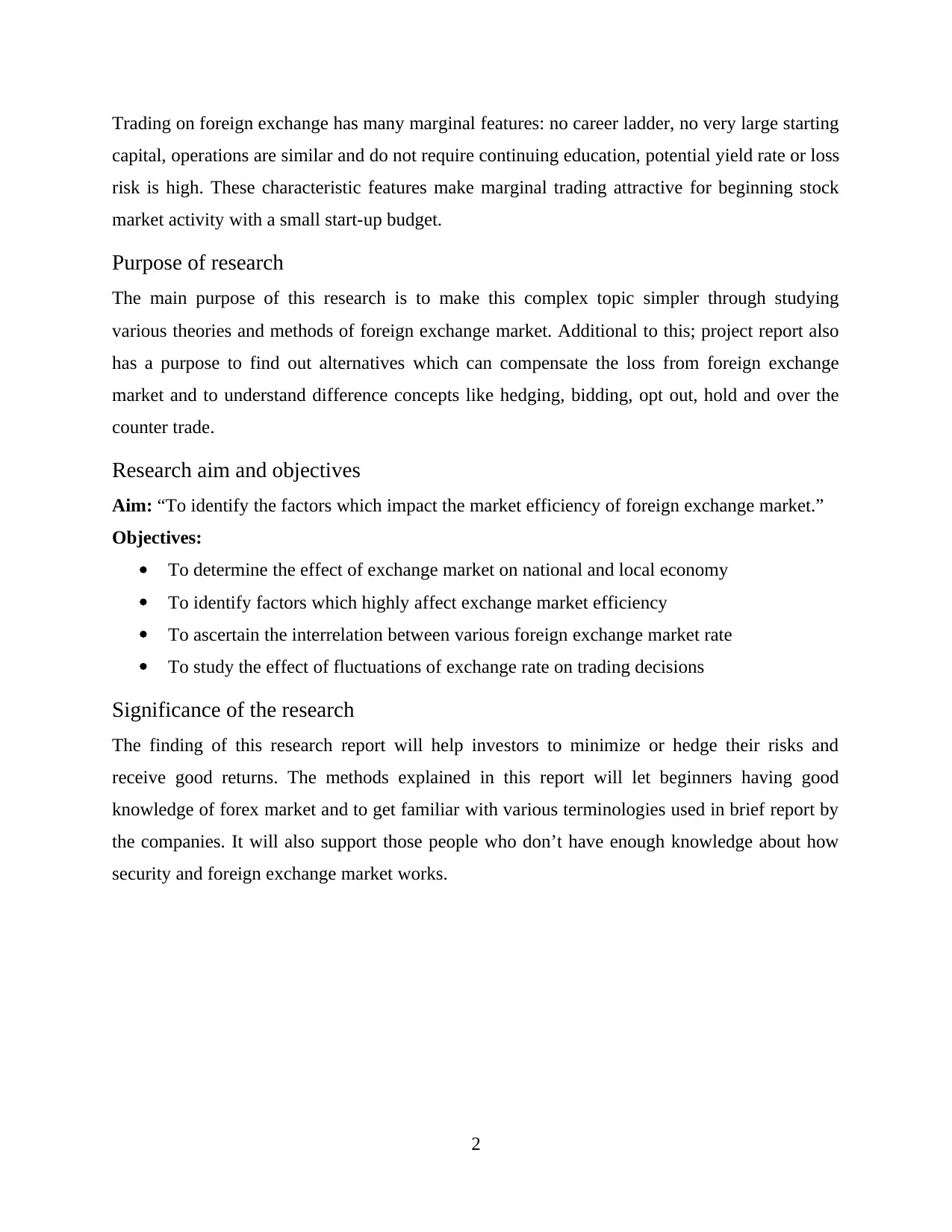
Trading on foreign exchange has many marginal features: no career ladder, no very large starting
capital, operations are similar and do not require continuing education, potential yield rate or loss
risk is high. These characteristic features make marginal trading attractive for beginning stock
market activity with a small start-up budget.
Purpose of research
The main purpose of this research is to make this complex topic simpler through studying
various theories and methods of foreign exchange market. Additional to this; project report also
has a purpose to find out alternatives which can compensate the loss from foreign exchange
market and to understand difference concepts like hedging, bidding, opt out, hold and over the
counter trade.
Research aim and objectives
Aim: “To identify the factors which impact the market efficiency of foreign exchange market.”
Objectives:
To determine the effect of exchange market on national and local economy
To identify factors which highly affect exchange market efficiency
To ascertain the interrelation between various foreign exchange market rate
To study the effect of fluctuations of exchange rate on trading decisions
Significance of the research
The finding of this research report will help investors to minimize or hedge their risks and
receive good returns. The methods explained in this report will let beginners having good
knowledge of forex market and to get familiar with various terminologies used in brief report by
the companies. It will also support those people who don’t have enough knowledge about how
security and foreign exchange market works.
2
capital, operations are similar and do not require continuing education, potential yield rate or loss
risk is high. These characteristic features make marginal trading attractive for beginning stock
market activity with a small start-up budget.
Purpose of research
The main purpose of this research is to make this complex topic simpler through studying
various theories and methods of foreign exchange market. Additional to this; project report also
has a purpose to find out alternatives which can compensate the loss from foreign exchange
market and to understand difference concepts like hedging, bidding, opt out, hold and over the
counter trade.
Research aim and objectives
Aim: “To identify the factors which impact the market efficiency of foreign exchange market.”
Objectives:
To determine the effect of exchange market on national and local economy
To identify factors which highly affect exchange market efficiency
To ascertain the interrelation between various foreign exchange market rate
To study the effect of fluctuations of exchange rate on trading decisions
Significance of the research
The finding of this research report will help investors to minimize or hedge their risks and
receive good returns. The methods explained in this report will let beginners having good
knowledge of forex market and to get familiar with various terminologies used in brief report by
the companies. It will also support those people who don’t have enough knowledge about how
security and foreign exchange market works.
2
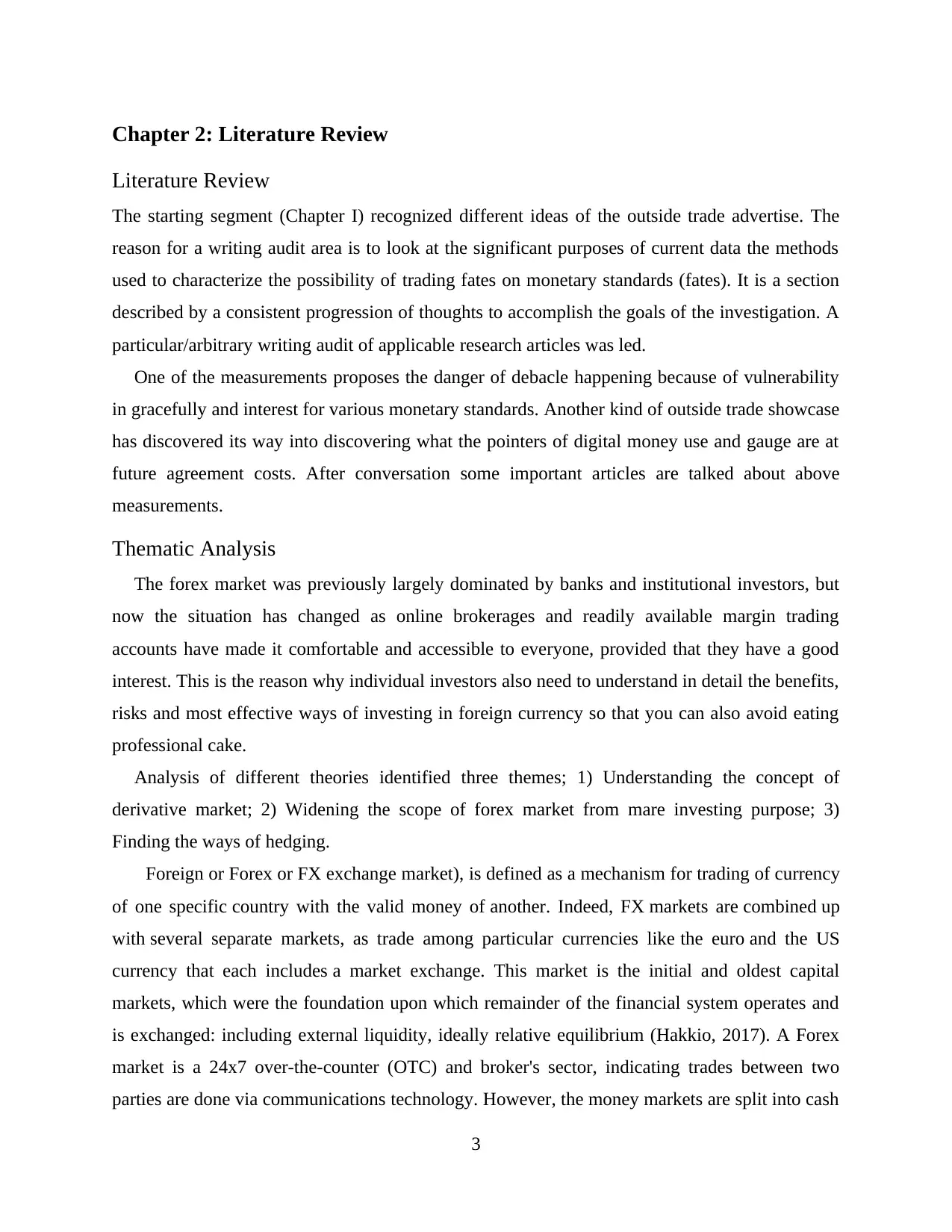
Chapter 2: Literature Review
Literature Review
The starting segment (Chapter I) recognized different ideas of the outside trade advertise. The
reason for a writing audit area is to look at the significant purposes of current data the methods
used to characterize the possibility of trading fates on monetary standards (fates). It is a section
described by a consistent progression of thoughts to accomplish the goals of the investigation. A
particular/arbitrary writing audit of applicable research articles was led.
One of the measurements proposes the danger of debacle happening because of vulnerability
in gracefully and interest for various monetary standards. Another kind of outside trade showcase
has discovered its way into discovering what the pointers of digital money use and gauge are at
future agreement costs. After conversation some important articles are talked about above
measurements.
Thematic Analysis
The forex market was previously largely dominated by banks and institutional investors, but
now the situation has changed as online brokerages and readily available margin trading
accounts have made it comfortable and accessible to everyone, provided that they have a good
interest. This is the reason why individual investors also need to understand in detail the benefits,
risks and most effective ways of investing in foreign currency so that you can also avoid eating
professional cake.
Analysis of different theories identified three themes; 1) Understanding the concept of
derivative market; 2) Widening the scope of forex market from mare investing purpose; 3)
Finding the ways of hedging.
Foreign or Forex or FX exchange market), is defined as a mechanism for trading of currency
of one specific country with the valid money of another. Indeed, FX markets are combined up
with several separate markets, as trade among particular currencies like the euro and the US
currency that each includes a market exchange. This market is the initial and oldest capital
markets, which were the foundation upon which remainder of the financial system operates and
is exchanged: including external liquidity, ideally relative equilibrium (Hakkio, 2017). A Forex
market is a 24x7 over-the-counter (OTC) and broker's sector, indicating trades between two
parties are done via communications technology. However, the money markets are split into cash
3
Literature Review
The starting segment (Chapter I) recognized different ideas of the outside trade advertise. The
reason for a writing audit area is to look at the significant purposes of current data the methods
used to characterize the possibility of trading fates on monetary standards (fates). It is a section
described by a consistent progression of thoughts to accomplish the goals of the investigation. A
particular/arbitrary writing audit of applicable research articles was led.
One of the measurements proposes the danger of debacle happening because of vulnerability
in gracefully and interest for various monetary standards. Another kind of outside trade showcase
has discovered its way into discovering what the pointers of digital money use and gauge are at
future agreement costs. After conversation some important articles are talked about above
measurements.
Thematic Analysis
The forex market was previously largely dominated by banks and institutional investors, but
now the situation has changed as online brokerages and readily available margin trading
accounts have made it comfortable and accessible to everyone, provided that they have a good
interest. This is the reason why individual investors also need to understand in detail the benefits,
risks and most effective ways of investing in foreign currency so that you can also avoid eating
professional cake.
Analysis of different theories identified three themes; 1) Understanding the concept of
derivative market; 2) Widening the scope of forex market from mare investing purpose; 3)
Finding the ways of hedging.
Foreign or Forex or FX exchange market), is defined as a mechanism for trading of currency
of one specific country with the valid money of another. Indeed, FX markets are combined up
with several separate markets, as trade among particular currencies like the euro and the US
currency that each includes a market exchange. This market is the initial and oldest capital
markets, which were the foundation upon which remainder of the financial system operates and
is exchanged: including external liquidity, ideally relative equilibrium (Hakkio, 2017). A Forex
market is a 24x7 over-the-counter (OTC) and broker's sector, indicating trades between two
parties are done via communications technology. However, the money markets are split into cash
3
⊘ This is a preview!⊘
Do you want full access?
Subscribe today to unlock all pages.

Trusted by 1+ million students worldwide
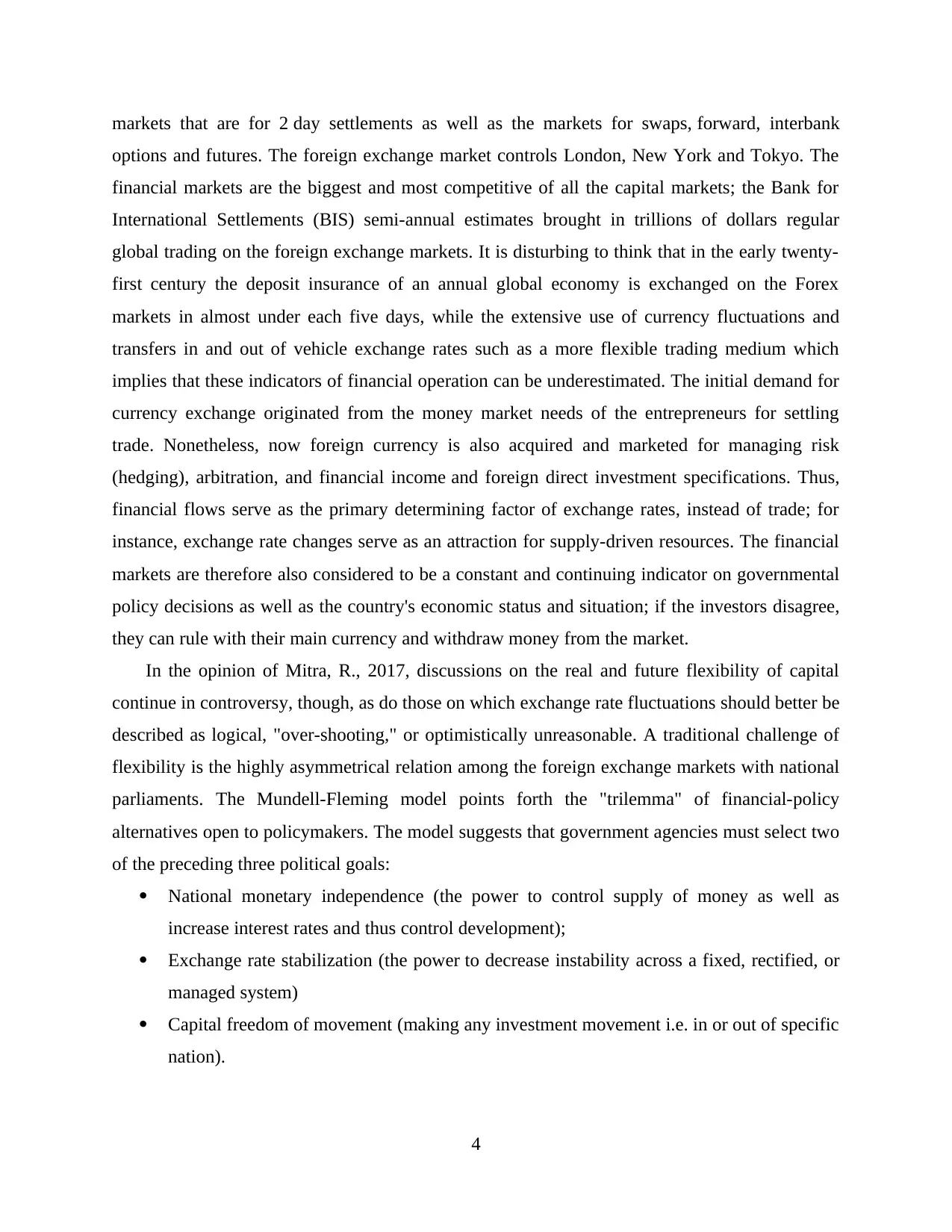
markets that are for 2 day settlements as well as the markets for swaps, forward, interbank
options and futures. The foreign exchange market controls London, New York and Tokyo. The
financial markets are the biggest and most competitive of all the capital markets; the Bank for
International Settlements (BIS) semi-annual estimates brought in trillions of dollars regular
global trading on the foreign exchange markets. It is disturbing to think that in the early twenty-
first century the deposit insurance of an annual global economy is exchanged on the Forex
markets in almost under each five days, while the extensive use of currency fluctuations and
transfers in and out of vehicle exchange rates such as a more flexible trading medium which
implies that these indicators of financial operation can be underestimated. The initial demand for
currency exchange originated from the money market needs of the entrepreneurs for settling
trade. Nonetheless, now foreign currency is also acquired and marketed for managing risk
(hedging), arbitration, and financial income and foreign direct investment specifications. Thus,
financial flows serve as the primary determining factor of exchange rates, instead of trade; for
instance, exchange rate changes serve as an attraction for supply-driven resources. The financial
markets are therefore also considered to be a constant and continuing indicator on governmental
policy decisions as well as the country's economic status and situation; if the investors disagree,
they can rule with their main currency and withdraw money from the market.
In the opinion of Mitra, R., 2017, discussions on the real and future flexibility of capital
continue in controversy, though, as do those on which exchange rate fluctuations should better be
described as logical, "over-shooting," or optimistically unreasonable. A traditional challenge of
flexibility is the highly asymmetrical relation among the foreign exchange markets with national
parliaments. The Mundell-Fleming model points forth the "trilemma" of financial-policy
alternatives open to policymakers. The model suggests that government agencies must select two
of the preceding three political goals:
National monetary independence (the power to control supply of money as well as
increase interest rates and thus control development);
Exchange rate stabilization (the power to decrease instability across a fixed, rectified, or
managed system)
Capital freedom of movement (making any investment movement i.e. in or out of specific
nation).
4
options and futures. The foreign exchange market controls London, New York and Tokyo. The
financial markets are the biggest and most competitive of all the capital markets; the Bank for
International Settlements (BIS) semi-annual estimates brought in trillions of dollars regular
global trading on the foreign exchange markets. It is disturbing to think that in the early twenty-
first century the deposit insurance of an annual global economy is exchanged on the Forex
markets in almost under each five days, while the extensive use of currency fluctuations and
transfers in and out of vehicle exchange rates such as a more flexible trading medium which
implies that these indicators of financial operation can be underestimated. The initial demand for
currency exchange originated from the money market needs of the entrepreneurs for settling
trade. Nonetheless, now foreign currency is also acquired and marketed for managing risk
(hedging), arbitration, and financial income and foreign direct investment specifications. Thus,
financial flows serve as the primary determining factor of exchange rates, instead of trade; for
instance, exchange rate changes serve as an attraction for supply-driven resources. The financial
markets are therefore also considered to be a constant and continuing indicator on governmental
policy decisions as well as the country's economic status and situation; if the investors disagree,
they can rule with their main currency and withdraw money from the market.
In the opinion of Mitra, R., 2017, discussions on the real and future flexibility of capital
continue in controversy, though, as do those on which exchange rate fluctuations should better be
described as logical, "over-shooting," or optimistically unreasonable. A traditional challenge of
flexibility is the highly asymmetrical relation among the foreign exchange markets with national
parliaments. The Mundell-Fleming model points forth the "trilemma" of financial-policy
alternatives open to policymakers. The model suggests that government agencies must select two
of the preceding three political goals:
National monetary independence (the power to control supply of money as well as
increase interest rates and thus control development);
Exchange rate stabilization (the power to decrease instability across a fixed, rectified, or
managed system)
Capital freedom of movement (making any investment movement i.e. in or out of specific
nation).
4
Paraphrase This Document
Need a fresh take? Get an instant paraphrase of this document with our AI Paraphraser
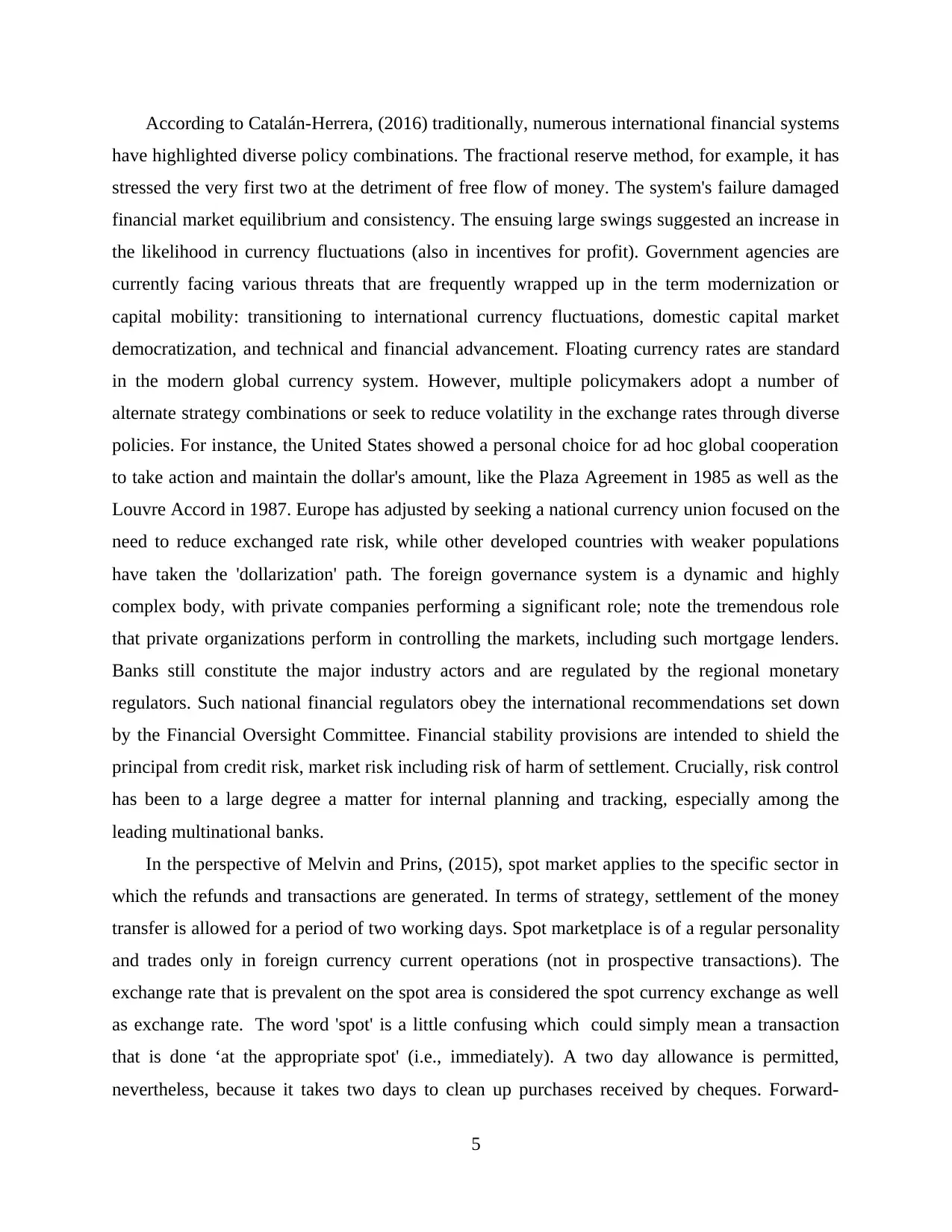
According to Catalán-Herrera, (2016) traditionally, numerous international financial systems
have highlighted diverse policy combinations. The fractional reserve method, for example, it has
stressed the very first two at the detriment of free flow of money. The system's failure damaged
financial market equilibrium and consistency. The ensuing large swings suggested an increase in
the likelihood in currency fluctuations (also in incentives for profit). Government agencies are
currently facing various threats that are frequently wrapped up in the term modernization or
capital mobility: transitioning to international currency fluctuations, domestic capital market
democratization, and technical and financial advancement. Floating currency rates are standard
in the modern global currency system. However, multiple policymakers adopt a number of
alternate strategy combinations or seek to reduce volatility in the exchange rates through diverse
policies. For instance, the United States showed a personal choice for ad hoc global cooperation
to take action and maintain the dollar's amount, like the Plaza Agreement in 1985 as well as the
Louvre Accord in 1987. Europe has adjusted by seeking a national currency union focused on the
need to reduce exchanged rate risk, while other developed countries with weaker populations
have taken the 'dollarization' path. The foreign governance system is a dynamic and highly
complex body, with private companies performing a significant role; note the tremendous role
that private organizations perform in controlling the markets, including such mortgage lenders.
Banks still constitute the major industry actors and are regulated by the regional monetary
regulators. Such national financial regulators obey the international recommendations set down
by the Financial Oversight Committee. Financial stability provisions are intended to shield the
principal from credit risk, market risk including risk of harm of settlement. Crucially, risk control
has been to a large degree a matter for internal planning and tracking, especially among the
leading multinational banks.
In the perspective of Melvin and Prins, (2015), spot market applies to the specific sector in
which the refunds and transactions are generated. In terms of strategy, settlement of the money
transfer is allowed for a period of two working days. Spot marketplace is of a regular personality
and trades only in foreign currency current operations (not in prospective transactions). The
exchange rate that is prevalent on the spot area is considered the spot currency exchange as well
as exchange rate. The word 'spot' is a little confusing which could simply mean a transaction
that is done ‘at the appropriate spot' (i.e., immediately). A two day allowance is permitted,
nevertheless, because it takes two days to clean up purchases received by cheques. Forward-
5
have highlighted diverse policy combinations. The fractional reserve method, for example, it has
stressed the very first two at the detriment of free flow of money. The system's failure damaged
financial market equilibrium and consistency. The ensuing large swings suggested an increase in
the likelihood in currency fluctuations (also in incentives for profit). Government agencies are
currently facing various threats that are frequently wrapped up in the term modernization or
capital mobility: transitioning to international currency fluctuations, domestic capital market
democratization, and technical and financial advancement. Floating currency rates are standard
in the modern global currency system. However, multiple policymakers adopt a number of
alternate strategy combinations or seek to reduce volatility in the exchange rates through diverse
policies. For instance, the United States showed a personal choice for ad hoc global cooperation
to take action and maintain the dollar's amount, like the Plaza Agreement in 1985 as well as the
Louvre Accord in 1987. Europe has adjusted by seeking a national currency union focused on the
need to reduce exchanged rate risk, while other developed countries with weaker populations
have taken the 'dollarization' path. The foreign governance system is a dynamic and highly
complex body, with private companies performing a significant role; note the tremendous role
that private organizations perform in controlling the markets, including such mortgage lenders.
Banks still constitute the major industry actors and are regulated by the regional monetary
regulators. Such national financial regulators obey the international recommendations set down
by the Financial Oversight Committee. Financial stability provisions are intended to shield the
principal from credit risk, market risk including risk of harm of settlement. Crucially, risk control
has been to a large degree a matter for internal planning and tracking, especially among the
leading multinational banks.
In the perspective of Melvin and Prins, (2015), spot market applies to the specific sector in
which the refunds and transactions are generated. In terms of strategy, settlement of the money
transfer is allowed for a period of two working days. Spot marketplace is of a regular personality
and trades only in foreign currency current operations (not in prospective transactions). The
exchange rate that is prevalent on the spot area is considered the spot currency exchange as well
as exchange rate. The word 'spot' is a little confusing which could simply mean a transaction
that is done ‘at the appropriate spot' (i.e., immediately). A two day allowance is permitted,
nevertheless, because it takes two days to clean up purchases received by cheques. Forward-
5
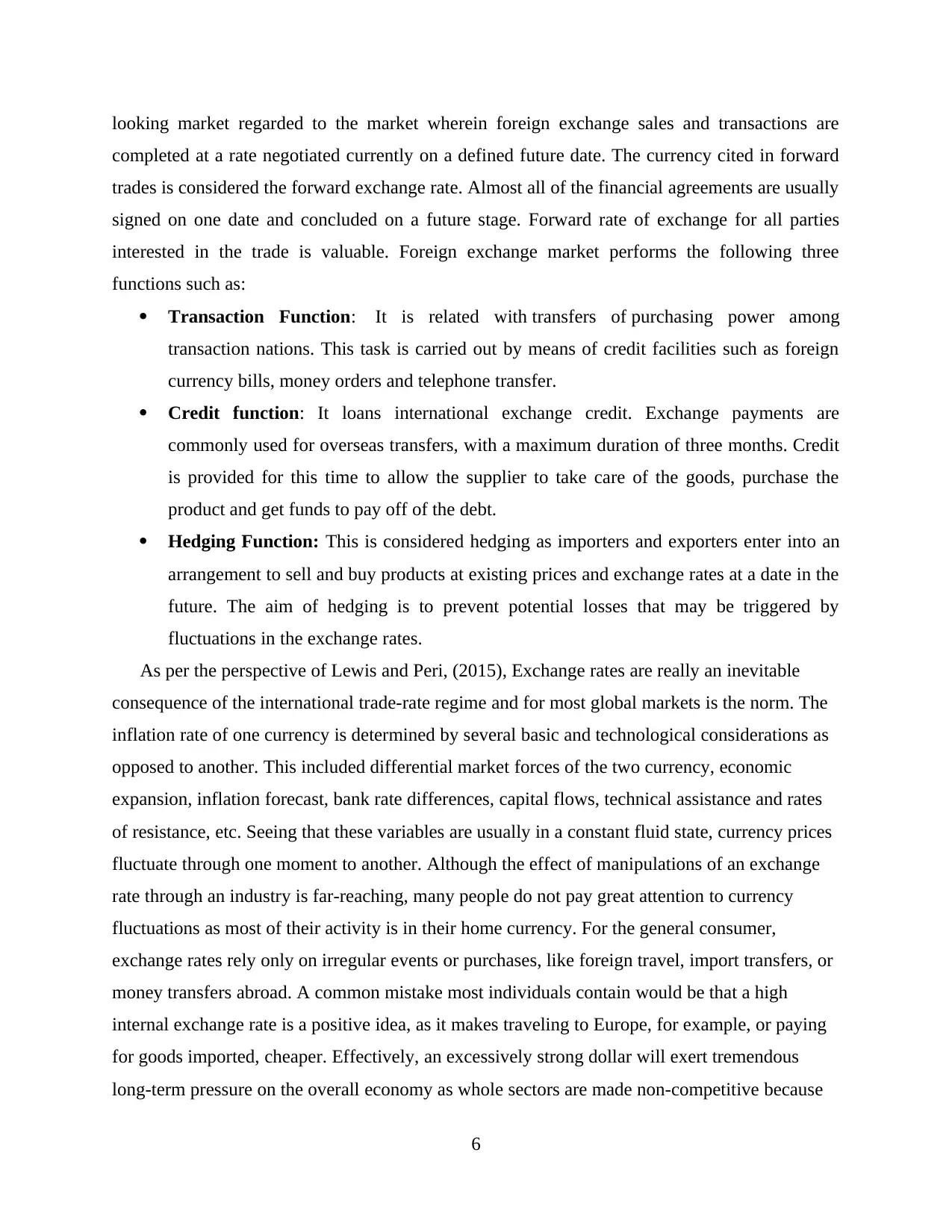
looking market regarded to the market wherein foreign exchange sales and transactions are
completed at a rate negotiated currently on a defined future date. The currency cited in forward
trades is considered the forward exchange rate. Almost all of the financial agreements are usually
signed on one date and concluded on a future stage. Forward rate of exchange for all parties
interested in the trade is valuable. Foreign exchange market performs the following three
functions such as:
Transaction Function: It is related with transfers of purchasing power among
transaction nations. This task is carried out by means of credit facilities such as foreign
currency bills, money orders and telephone transfer.
Credit function: It loans international exchange credit. Exchange payments are
commonly used for overseas transfers, with a maximum duration of three months. Credit
is provided for this time to allow the supplier to take care of the goods, purchase the
product and get funds to pay off of the debt.
Hedging Function: This is considered hedging as importers and exporters enter into an
arrangement to sell and buy products at existing prices and exchange rates at a date in the
future. The aim of hedging is to prevent potential losses that may be triggered by
fluctuations in the exchange rates.
As per the perspective of Lewis and Peri, (2015), Exchange rates are really an inevitable
consequence of the international trade-rate regime and for most global markets is the norm. The
inflation rate of one currency is determined by several basic and technological considerations as
opposed to another. This included differential market forces of the two currency, economic
expansion, inflation forecast, bank rate differences, capital flows, technical assistance and rates
of resistance, etc. Seeing that these variables are usually in a constant fluid state, currency prices
fluctuate through one moment to another. Although the effect of manipulations of an exchange
rate through an industry is far-reaching, many people do not pay great attention to currency
fluctuations as most of their activity is in their home currency. For the general consumer,
exchange rates rely only on irregular events or purchases, like foreign travel, import transfers, or
money transfers abroad. A common mistake most individuals contain would be that a high
internal exchange rate is a positive idea, as it makes traveling to Europe, for example, or paying
for goods imported, cheaper. Effectively, an excessively strong dollar will exert tremendous
long-term pressure on the overall economy as whole sectors are made non-competitive because
6
completed at a rate negotiated currently on a defined future date. The currency cited in forward
trades is considered the forward exchange rate. Almost all of the financial agreements are usually
signed on one date and concluded on a future stage. Forward rate of exchange for all parties
interested in the trade is valuable. Foreign exchange market performs the following three
functions such as:
Transaction Function: It is related with transfers of purchasing power among
transaction nations. This task is carried out by means of credit facilities such as foreign
currency bills, money orders and telephone transfer.
Credit function: It loans international exchange credit. Exchange payments are
commonly used for overseas transfers, with a maximum duration of three months. Credit
is provided for this time to allow the supplier to take care of the goods, purchase the
product and get funds to pay off of the debt.
Hedging Function: This is considered hedging as importers and exporters enter into an
arrangement to sell and buy products at existing prices and exchange rates at a date in the
future. The aim of hedging is to prevent potential losses that may be triggered by
fluctuations in the exchange rates.
As per the perspective of Lewis and Peri, (2015), Exchange rates are really an inevitable
consequence of the international trade-rate regime and for most global markets is the norm. The
inflation rate of one currency is determined by several basic and technological considerations as
opposed to another. This included differential market forces of the two currency, economic
expansion, inflation forecast, bank rate differences, capital flows, technical assistance and rates
of resistance, etc. Seeing that these variables are usually in a constant fluid state, currency prices
fluctuate through one moment to another. Although the effect of manipulations of an exchange
rate through an industry is far-reaching, many people do not pay great attention to currency
fluctuations as most of their activity is in their home currency. For the general consumer,
exchange rates rely only on irregular events or purchases, like foreign travel, import transfers, or
money transfers abroad. A common mistake most individuals contain would be that a high
internal exchange rate is a positive idea, as it makes traveling to Europe, for example, or paying
for goods imported, cheaper. Effectively, an excessively strong dollar will exert tremendous
long-term pressure on the overall economy as whole sectors are made non-competitive because
6
⊘ This is a preview!⊘
Do you want full access?
Subscribe today to unlock all pages.

Trusted by 1+ million students worldwide
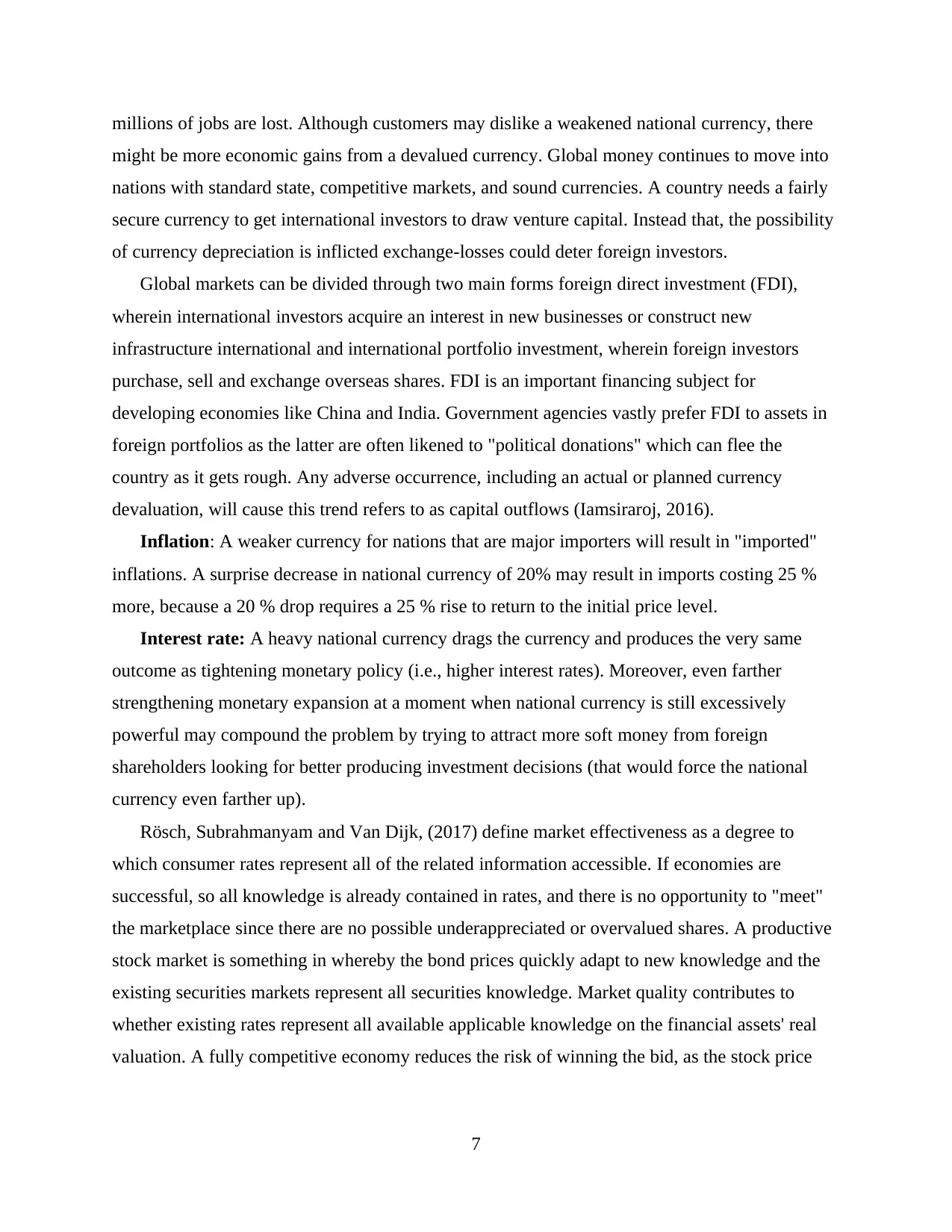
millions of jobs are lost. Although customers may dislike a weakened national currency, there
might be more economic gains from a devalued currency. Global money continues to move into
nations with standard state, competitive markets, and sound currencies. A country needs a fairly
secure currency to get international investors to draw venture capital. Instead that, the possibility
of currency depreciation is inflicted exchange-losses could deter foreign investors.
Global markets can be divided through two main forms foreign direct investment (FDI),
wherein international investors acquire an interest in new businesses or construct new
infrastructure international and international portfolio investment, wherein foreign investors
purchase, sell and exchange overseas shares. FDI is an important financing subject for
developing economies like China and India. Government agencies vastly prefer FDI to assets in
foreign portfolios as the latter are often likened to "political donations" which can flee the
country as it gets rough. Any adverse occurrence, including an actual or planned currency
devaluation, will cause this trend refers to as capital outflows (Iamsiraroj, 2016).
Inflation: A weaker currency for nations that are major importers will result in "imported"
inflations. A surprise decrease in national currency of 20% may result in imports costing 25 %
more, because a 20 % drop requires a 25 % rise to return to the initial price level.
Interest rate: A heavy national currency drags the currency and produces the very same
outcome as tightening monetary policy (i.e., higher interest rates). Moreover, even farther
strengthening monetary expansion at a moment when national currency is still excessively
powerful may compound the problem by trying to attract more soft money from foreign
shareholders looking for better producing investment decisions (that would force the national
currency even farther up).
Rösch, Subrahmanyam and Van Dijk, (2017) define market effectiveness as a degree to
which consumer rates represent all of the related information accessible. If economies are
successful, so all knowledge is already contained in rates, and there is no opportunity to "meet"
the marketplace since there are no possible underappreciated or overvalued shares. A productive
stock market is something in whereby the bond prices quickly adapt to new knowledge and the
existing securities markets represent all securities knowledge. Market quality contributes to
whether existing rates represent all available applicable knowledge on the financial assets' real
valuation. A fully competitive economy reduces the risk of winning the bid, as the stock price
7
might be more economic gains from a devalued currency. Global money continues to move into
nations with standard state, competitive markets, and sound currencies. A country needs a fairly
secure currency to get international investors to draw venture capital. Instead that, the possibility
of currency depreciation is inflicted exchange-losses could deter foreign investors.
Global markets can be divided through two main forms foreign direct investment (FDI),
wherein international investors acquire an interest in new businesses or construct new
infrastructure international and international portfolio investment, wherein foreign investors
purchase, sell and exchange overseas shares. FDI is an important financing subject for
developing economies like China and India. Government agencies vastly prefer FDI to assets in
foreign portfolios as the latter are often likened to "political donations" which can flee the
country as it gets rough. Any adverse occurrence, including an actual or planned currency
devaluation, will cause this trend refers to as capital outflows (Iamsiraroj, 2016).
Inflation: A weaker currency for nations that are major importers will result in "imported"
inflations. A surprise decrease in national currency of 20% may result in imports costing 25 %
more, because a 20 % drop requires a 25 % rise to return to the initial price level.
Interest rate: A heavy national currency drags the currency and produces the very same
outcome as tightening monetary policy (i.e., higher interest rates). Moreover, even farther
strengthening monetary expansion at a moment when national currency is still excessively
powerful may compound the problem by trying to attract more soft money from foreign
shareholders looking for better producing investment decisions (that would force the national
currency even farther up).
Rösch, Subrahmanyam and Van Dijk, (2017) define market effectiveness as a degree to
which consumer rates represent all of the related information accessible. If economies are
successful, so all knowledge is already contained in rates, and there is no opportunity to "meet"
the marketplace since there are no possible underappreciated or overvalued shares. A productive
stock market is something in whereby the bond prices quickly adapt to new knowledge and the
existing securities markets represent all securities knowledge. Market quality contributes to
whether existing rates represent all available applicable knowledge on the financial assets' real
valuation. A fully competitive economy reduces the risk of winning the bid, as the stock price
7
Paraphrase This Document
Need a fresh take? Get an instant paraphrase of this document with our AI Paraphraser
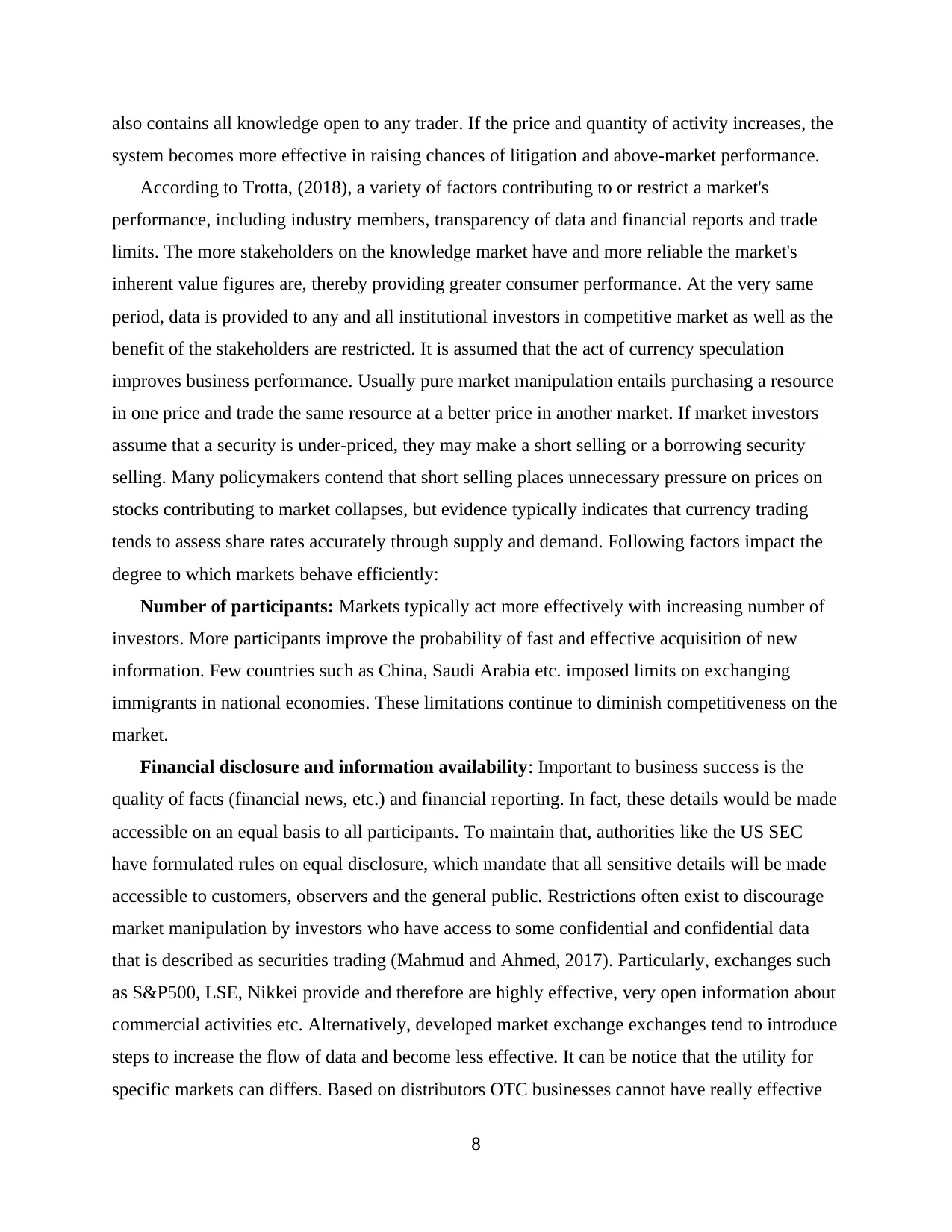
also contains all knowledge open to any trader. If the price and quantity of activity increases, the
system becomes more effective in raising chances of litigation and above-market performance.
According to Trotta, (2018), a variety of factors contributing to or restrict a market's
performance, including industry members, transparency of data and financial reports and trade
limits. The more stakeholders on the knowledge market have and more reliable the market's
inherent value figures are, thereby providing greater consumer performance. At the very same
period, data is provided to any and all institutional investors in competitive market as well as the
benefit of the stakeholders are restricted. It is assumed that the act of currency speculation
improves business performance. Usually pure market manipulation entails purchasing a resource
in one price and trade the same resource at a better price in another market. If market investors
assume that a security is under-priced, they may make a short selling or a borrowing security
selling. Many policymakers contend that short selling places unnecessary pressure on prices on
stocks contributing to market collapses, but evidence typically indicates that currency trading
tends to assess share rates accurately through supply and demand. Following factors impact the
degree to which markets behave efficiently:
Number of participants: Markets typically act more effectively with increasing number of
investors. More participants improve the probability of fast and effective acquisition of new
information. Few countries such as China, Saudi Arabia etc. imposed limits on exchanging
immigrants in national economies. These limitations continue to diminish competitiveness on the
market.
Financial disclosure and information availability: Important to business success is the
quality of facts (financial news, etc.) and financial reporting. In fact, these details would be made
accessible on an equal basis to all participants. To maintain that, authorities like the US SEC
have formulated rules on equal disclosure, which mandate that all sensitive details will be made
accessible to customers, observers and the general public. Restrictions often exist to discourage
market manipulation by investors who have access to some confidential and confidential data
that is described as securities trading (Mahmud and Ahmed, 2017). Particularly, exchanges such
as S&P500, LSE, Nikkei provide and therefore are highly effective, very open information about
commercial activities etc. Alternatively, developed market exchange exchanges tend to introduce
steps to increase the flow of data and become less effective. It can be notice that the utility for
specific markets can differs. Based on distributors OTC businesses cannot have really effective
8
system becomes more effective in raising chances of litigation and above-market performance.
According to Trotta, (2018), a variety of factors contributing to or restrict a market's
performance, including industry members, transparency of data and financial reports and trade
limits. The more stakeholders on the knowledge market have and more reliable the market's
inherent value figures are, thereby providing greater consumer performance. At the very same
period, data is provided to any and all institutional investors in competitive market as well as the
benefit of the stakeholders are restricted. It is assumed that the act of currency speculation
improves business performance. Usually pure market manipulation entails purchasing a resource
in one price and trade the same resource at a better price in another market. If market investors
assume that a security is under-priced, they may make a short selling or a borrowing security
selling. Many policymakers contend that short selling places unnecessary pressure on prices on
stocks contributing to market collapses, but evidence typically indicates that currency trading
tends to assess share rates accurately through supply and demand. Following factors impact the
degree to which markets behave efficiently:
Number of participants: Markets typically act more effectively with increasing number of
investors. More participants improve the probability of fast and effective acquisition of new
information. Few countries such as China, Saudi Arabia etc. imposed limits on exchanging
immigrants in national economies. These limitations continue to diminish competitiveness on the
market.
Financial disclosure and information availability: Important to business success is the
quality of facts (financial news, etc.) and financial reporting. In fact, these details would be made
accessible on an equal basis to all participants. To maintain that, authorities like the US SEC
have formulated rules on equal disclosure, which mandate that all sensitive details will be made
accessible to customers, observers and the general public. Restrictions often exist to discourage
market manipulation by investors who have access to some confidential and confidential data
that is described as securities trading (Mahmud and Ahmed, 2017). Particularly, exchanges such
as S&P500, LSE, Nikkei provide and therefore are highly effective, very open information about
commercial activities etc. Alternatively, developed market exchange exchanges tend to introduce
steps to increase the flow of data and become less effective. It can be notice that the utility for
specific markets can differs. Based on distributors OTC businesses cannot have really effective
8
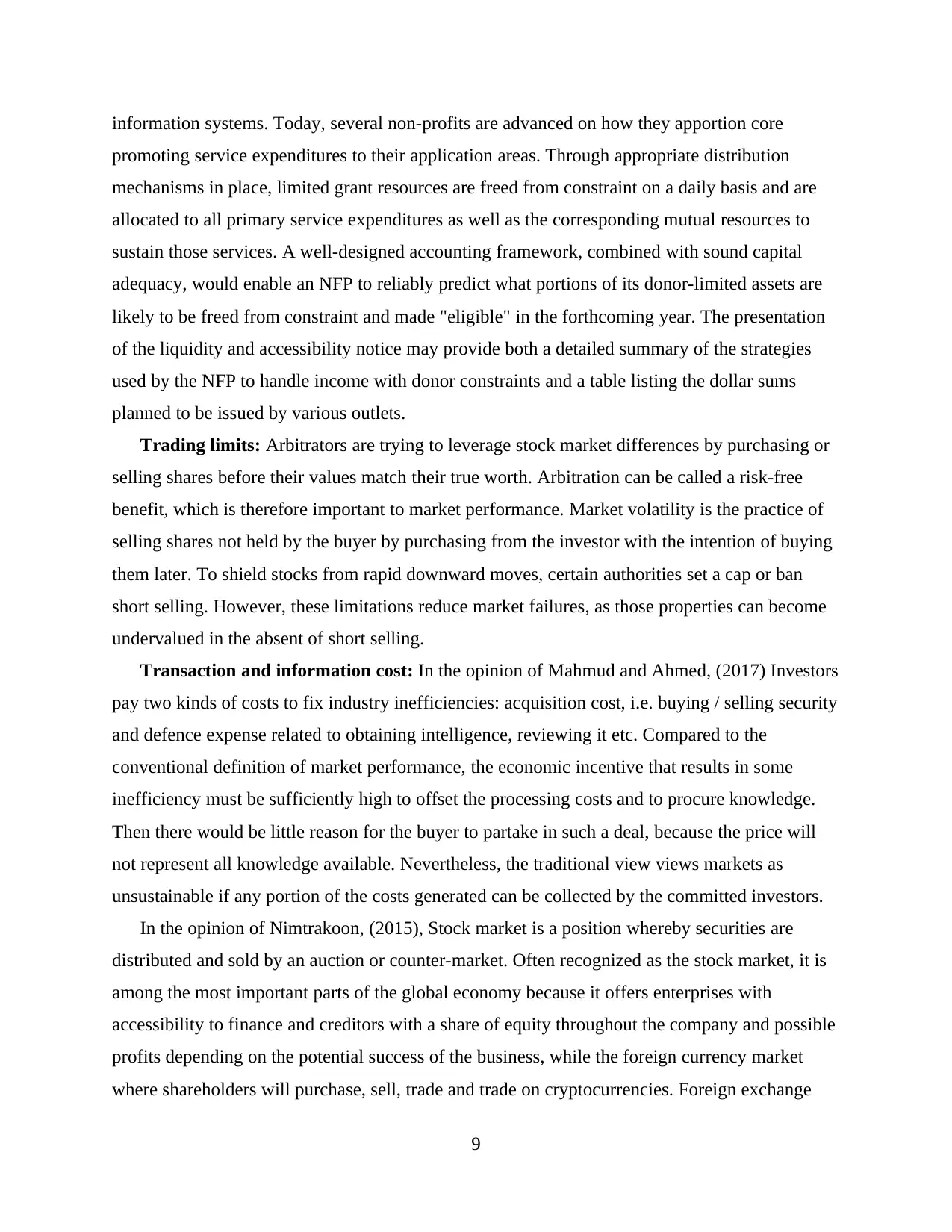
information systems. Today, several non-profits are advanced on how they apportion core
promoting service expenditures to their application areas. Through appropriate distribution
mechanisms in place, limited grant resources are freed from constraint on a daily basis and are
allocated to all primary service expenditures as well as the corresponding mutual resources to
sustain those services. A well-designed accounting framework, combined with sound capital
adequacy, would enable an NFP to reliably predict what portions of its donor-limited assets are
likely to be freed from constraint and made "eligible" in the forthcoming year. The presentation
of the liquidity and accessibility notice may provide both a detailed summary of the strategies
used by the NFP to handle income with donor constraints and a table listing the dollar sums
planned to be issued by various outlets.
Trading limits: Arbitrators are trying to leverage stock market differences by purchasing or
selling shares before their values match their true worth. Arbitration can be called a risk-free
benefit, which is therefore important to market performance. Market volatility is the practice of
selling shares not held by the buyer by purchasing from the investor with the intention of buying
them later. To shield stocks from rapid downward moves, certain authorities set a cap or ban
short selling. However, these limitations reduce market failures, as those properties can become
undervalued in the absent of short selling.
Transaction and information cost: In the opinion of Mahmud and Ahmed, (2017) Investors
pay two kinds of costs to fix industry inefficiencies: acquisition cost, i.e. buying / selling security
and defence expense related to obtaining intelligence, reviewing it etc. Compared to the
conventional definition of market performance, the economic incentive that results in some
inefficiency must be sufficiently high to offset the processing costs and to procure knowledge.
Then there would be little reason for the buyer to partake in such a deal, because the price will
not represent all knowledge available. Nevertheless, the traditional view views markets as
unsustainable if any portion of the costs generated can be collected by the committed investors.
In the opinion of Nimtrakoon, (2015), Stock market is a position whereby securities are
distributed and sold by an auction or counter-market. Often recognized as the stock market, it is
among the most important parts of the global economy because it offers enterprises with
accessibility to finance and creditors with a share of equity throughout the company and possible
profits depending on the potential success of the business, while the foreign currency market
where shareholders will purchase, sell, trade and trade on cryptocurrencies. Foreign exchange
9
promoting service expenditures to their application areas. Through appropriate distribution
mechanisms in place, limited grant resources are freed from constraint on a daily basis and are
allocated to all primary service expenditures as well as the corresponding mutual resources to
sustain those services. A well-designed accounting framework, combined with sound capital
adequacy, would enable an NFP to reliably predict what portions of its donor-limited assets are
likely to be freed from constraint and made "eligible" in the forthcoming year. The presentation
of the liquidity and accessibility notice may provide both a detailed summary of the strategies
used by the NFP to handle income with donor constraints and a table listing the dollar sums
planned to be issued by various outlets.
Trading limits: Arbitrators are trying to leverage stock market differences by purchasing or
selling shares before their values match their true worth. Arbitration can be called a risk-free
benefit, which is therefore important to market performance. Market volatility is the practice of
selling shares not held by the buyer by purchasing from the investor with the intention of buying
them later. To shield stocks from rapid downward moves, certain authorities set a cap or ban
short selling. However, these limitations reduce market failures, as those properties can become
undervalued in the absent of short selling.
Transaction and information cost: In the opinion of Mahmud and Ahmed, (2017) Investors
pay two kinds of costs to fix industry inefficiencies: acquisition cost, i.e. buying / selling security
and defence expense related to obtaining intelligence, reviewing it etc. Compared to the
conventional definition of market performance, the economic incentive that results in some
inefficiency must be sufficiently high to offset the processing costs and to procure knowledge.
Then there would be little reason for the buyer to partake in such a deal, because the price will
not represent all knowledge available. Nevertheless, the traditional view views markets as
unsustainable if any portion of the costs generated can be collected by the committed investors.
In the opinion of Nimtrakoon, (2015), Stock market is a position whereby securities are
distributed and sold by an auction or counter-market. Often recognized as the stock market, it is
among the most important parts of the global economy because it offers enterprises with
accessibility to finance and creditors with a share of equity throughout the company and possible
profits depending on the potential success of the business, while the foreign currency market
where shareholders will purchase, sell, trade and trade on cryptocurrencies. Foreign exchange
9
⊘ This is a preview!⊘
Do you want full access?
Subscribe today to unlock all pages.

Trusted by 1+ million students worldwide
1 out of 31
Related Documents
Your All-in-One AI-Powered Toolkit for Academic Success.
+13062052269
info@desklib.com
Available 24*7 on WhatsApp / Email
![[object Object]](/_next/static/media/star-bottom.7253800d.svg)
Unlock your academic potential
Copyright © 2020–2025 A2Z Services. All Rights Reserved. Developed and managed by ZUCOL.





